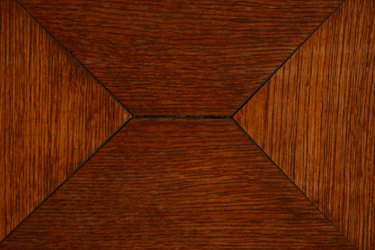 Brazilian cherry wood flooring comes from the Jatoba tree.
Brazilian cherry wood flooring comes from the Jatoba tree.
Brazilian cherry wood (Hymenaea courbaril) comes from the Jatoba tree, a species indigenous to South and Central America. Harder than oak, it's durable, doesn't dent easily and is insect-resistant. Many flooring outlets carry pre-finished Brazilian cherry wood flooring with a clear finish. A clear finish accentuates the reddish undertones of the wood. But unfinished Brazilian cherry wood stains well and is solid.
Video of the Day
Properties of Brazilian Cherry Wood
Among hardwoods, Brazilian cherry wood is one of the harder species. On the Janka scale of hardness, a test that measures a wood's resistance to denting, Brazilian cherry wood is rated at 2350. As a comparison, mahogany is rated at 2200. Oak, a common hardwood used for flooring, averages around 1300. This hardness, as well as its insect-resistant properties and adaptable appearance, makes it a popular flooring choice.
Preparation for Sanding
Though clear stain brings out the natural reddish-brown hues of the wood, Brazilian cherry wood adapts to most stains. To prepare wood for staining, it must be sanded. Because of this wood's hardness, County Flooring recommends you sand and finish the floors professionally.
Stains
Brazilian cherry wood''s color becomes more pronounced with age. When you choose a stain, consider that it will grow darker over time. Also, there are wide color variations in this wood species. According to Flooring Professor, flooring from the sapwood is grayish-white; heartwood has a red to orange-brown hue in the beginning, which deepens to a reddish brown with age. Directional grain variations exist in Brazilian cherry wood, and any stain will enhance the grain. Water- and oil-based stains are available. While a water-based finish preserves the natural color longer; oil-based stains accentuate the wood's natural red hues. A shellac or varnish is recommended over the stain.
Maintenance
Care and cleaning Brazilian cherry wood is no different than doing so for any hardwood. The Flooring Professor recommends you sweep, dust mop or vacuum the wood daily. Loosen any debris lodged in natural grooves of the grain. A citrus-based wood cleaner is suitable for daily maintenance. For deep cleaning, many flooring installers carry mop kits with specialty cleaners and polishers. Ask your supplier for recommendations.


